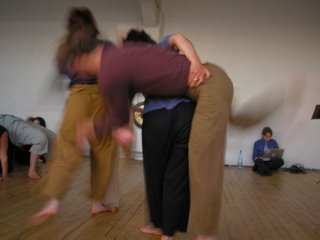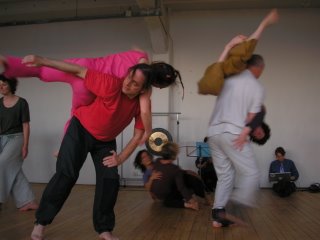 Photos: Michelle Campbell
Photos: Michelle Campbell
So I have finally played a concert actually within Paris. (This gig report will be more exciting than normal.) Broken into chapters because it’s so long.
I showed up around 5:30 to the space. On the way there, I passed the street address that was on the posters. It was a completely different building, half a block away. Wonderful thing #1. So I went down the street and hung a flyer on the other building (I had to explain in broken French to a resident what I was doing. She thought it very reasonable. That’s a nice thing about French people: if you are doing something completely crazy but have a story behind it, they find it totally reasonable. More on this later). I drew a big arrow under the flyer on the gaffing tape I used to hang it up. I dropped my gaffing tape and it rolled into traffic. I retrieved it. I hung a flyer up outside the correct building. I went to the studio.
The flutist and and the person who arranged to rent the studio (henceforth: Romeo) showed up and started talking about how the owner had double booked, but they’d brought the rental contract with them and certainly we could work something out. Of course whatever class was going on would want musical accompaniment and spectators! (uh… sure.) Meanwhile, they went knocking on the doors of all the other studios in the building and asking if we could use their space.
“Good afternoon. I’m knocking on your door because of a situation that’s peculiar . . . [fast french explanation] . . . so because it’s kind of an emergency, we were wondering if perhaps we could use your space?”
An architect said yes, but his studio was ill-suited. Nobody else was home. I can’t say exactly what happened as Romeo and the flutist went around, because I stayed behind, much to the flutist’s annoyance. In my defense: I could barely follow the conversations (which requires great concentration, which is difficult to sustain while stressed) and I have something of a tendency to tune out during such situations. Um anyway.
 So we got into the studio that we rented and put our gear in there. As we were just setting down our bags, the owner came storming in and threw my balled up flyer at me. “There will be no concert tonight!” The flutist and him promptly started shouting at each other totally on top of each other. A great deal of French conversation involves a high degree of overlap. It makes it even harder to follow. But in this case, it didn’t matter because they weren’t listening to each other anyway. A fairly high amount of French conversation also includes such shouting. Somehow in the midst of this, the flutist asked him if he was Italian. “What’s that got to do with anything?” he demanded. I think she called him macho. This is not the tactic I would have taken. She explained that Romeo, who had suddenly disappeared about five minutes before this happened, had a contract for the space. He said that she did not and went into a long monologue about how Romeo was a bastard and was unwilling to compromise. “Italy is the land of compromise!!” He told us to leave. I said that Romeo wasn’t here. I didn’t even know Romeo. He seemed like a reasonable man. I had come from another continent. If a compromise existed, I was sure we could find it. He said it was nothing personal, but we weren’t on the contract Romeo was and my god, she’s a bastard blah blah blah blah blah. Pacing back and forth with his hands behind his back and his head down, like a parody of closing arguments to the jury. Who was he trying to convince of his innocence?
So we got into the studio that we rented and put our gear in there. As we were just setting down our bags, the owner came storming in and threw my balled up flyer at me. “There will be no concert tonight!” The flutist and him promptly started shouting at each other totally on top of each other. A great deal of French conversation involves a high degree of overlap. It makes it even harder to follow. But in this case, it didn’t matter because they weren’t listening to each other anyway. A fairly high amount of French conversation also includes such shouting. Somehow in the midst of this, the flutist asked him if he was Italian. “What’s that got to do with anything?” he demanded. I think she called him macho. This is not the tactic I would have taken. She explained that Romeo, who had suddenly disappeared about five minutes before this happened, had a contract for the space. He said that she did not and went into a long monologue about how Romeo was a bastard and was unwilling to compromise. “Italy is the land of compromise!!” He told us to leave. I said that Romeo wasn’t here. I didn’t even know Romeo. He seemed like a reasonable man. I had come from another continent. If a compromise existed, I was sure we could find it. He said it was nothing personal, but we weren’t on the contract Romeo was and my god, she’s a bastard blah blah blah blah blah. Pacing back and forth with his hands behind his back and his head down, like a parody of closing arguments to the jury. Who was he trying to convince of his innocence?
This went nowhere fast. So we moved our gear back into the hall while I swore to leave France and Europe and never return, when Durian guy showed up. (past encounters) He had a dance class upstairs which was about to start. “You should play for our class!”
The flutist had been in previous contact with the dance class organizers who said “maybe.” The person actually leading the class had to agree, as did the dancers and it would be better if we found another solution. Well, the flutist’s gf was in the dance class, as was durian guy and they were both excited about the possibility and charismatic. Most of the dancers thought it was crazy, but we had a story and thus they were convinced. so we set up in the studio whilst their class started. they do something called “Dance Contact.” I had never heard of this, but apparently, it’s from San Francisco. It’s a type of improvised dance where people sort of roll around on top of each other and climb on each other. I saw the Merce Cunningham dance company do similar style of dance once, and of course, I’ve seen people do this type of dancing, because I actually am from San Francisco, even if I’ve never heard the name of this very very famous dance from there.
It was around this time that Romeo reappeared and offered to let people in the gate downstairs.
I want to take a moment to mention Cola’s contributions. She did extra chores for weeks whilst I wrote sheet music and programs. She purchased all the refreshments for the concert. She copied the programs. She folded the programs. She biked up a steep hill to the space with half my gear. She ran random errands. She handed out programs to people as they arrived. Yay Cola!
 People started to show up and seemed amused and intrigued by the venue change. The tech from my school took of his shoes and started rolling around with the regular dancers. Dancing actually is not quiet. There are foot drags along the floor. Thumps of footfalls (and other falls at people climbed on each other and sometimes fell). Occasional giggling. the dancers talked a bit. It felt very Christian Wolf. The best piece on the program for this situation was one called Black Intention by Ishii. It involves a performance aspect of playing two recorders at once faster and faster and faster until it’s unplayable, followed by a scream of frustration, a run across the stage and a gong hit. The dancers cheered. I want to write a piece like that.
People started to show up and seemed amused and intrigued by the venue change. The tech from my school took of his shoes and started rolling around with the regular dancers. Dancing actually is not quiet. There are foot drags along the floor. Thumps of footfalls (and other falls at people climbed on each other and sometimes fell). Occasional giggling. the dancers talked a bit. It felt very Christian Wolf. The best piece on the program for this situation was one called Black Intention by Ishii. It involves a performance aspect of playing two recorders at once faster and faster and faster until it’s unplayable, followed by a scream of frustration, a run across the stage and a gong hit. The dancers cheered. I want to write a piece like that.
Most of my computer pieces are realized in real-time and often changed to fit the space (for example, the distance between the speakers is part of my spatialization algorithm). However, there are those who complain about a lack of performance aspect. Screw that, I’m just going to play at dance studios from now on. Usually, it’s wise to avoid visuals because they tend to dominate. But I think this is especially true for certain kinds of visuals, especially those that oscillate around 50 or 60 hz (read: video). Video has a demonstrably hypnotic effect and we’re trained via television to concentrate on the images. Dancers improvising in the setting sun, by contrast, is lovely and ads something rather than distracts.
We closed with an extra improvisation. I ended up not running any fx whatsoever on the samples, but just making loops and playing them back selectively. I had some previously recorded samples of the gong, one of the audience members giggling (during an interview for another piece) and somebody shouting “goaaaaaal!” in honor of the start of the World Cup. It was simple but nice and went well with the dancing.
The only downsides were that Multis, a piece that had like 3754692365 previous drafts was deemed “too rhythmic” for the dancers. And we couldn’t collect a cover since we were in the wrong room. (I forgot to mention the cover on email anyway so we had already decided to make it optional.) One Renaissance recorder player, however, was so tickled by the whole thing that she insisted on paying anyway.
Yet another day in which I hate France but then things turn out so well, that I am totally charmed by the culture. This country is a lesson in serenity. Everything just ends up working out.
Tags: Gig, Dance Contact, Paris, Celesteh


